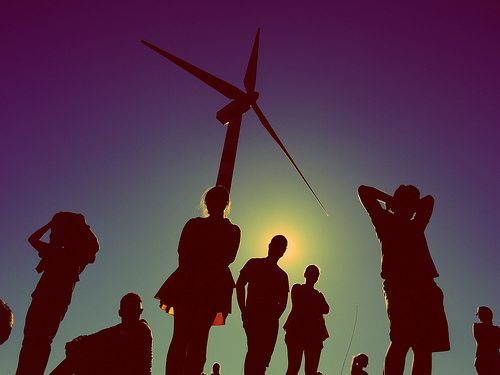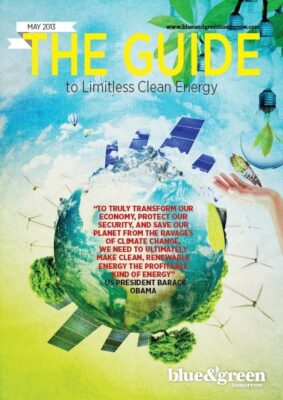

Economy
Community energy: what you need to know
The UK’s first Community Energy Fortnight began on Saturday, hoping to inspire and engage people with the concept of community energy. Francesca Baker looks at what this means, and picks out a few of the UK’s most successful initiatives. Who knows; they may even be on your very own doorstop.
Energy comes from the big companies, right? The TV works because some multinational pumps electricity to it, and we keep warm because years ago, British Gas was set up and spawned hundreds of other companies.
While this may be the case, there is an alternative. Community energy is simply the act of, or the output from, people coming together to fuel the activities of their local area and the people who live within it.
Saving energy, and generating it, are hot topics, and in recent years we have seen things change, so that like many areas of concern it seems wholly natural and obvious to harness it at a community level.
The reasons for this growing trend are well documented, but important enough to be documented again. Climate change has highlighted a need to find alternative solutions for fossil fuels.
The average UK citizen emits 10 tonnes of carbon dioxide into the paper thin ozone layer every year. The dwindling natural resources of oil, gas, and coal – fossil fuels – is not only causing environmental problems but economic ones, thrusting prices higher and higher as companies and governments fear that fuel tipping point.
Even if we don’t run out, political and precarious international relations are often the basis of so many of the fuel transactions that things may get more and more precarious.
Higher costs of the raw materials mean higher energy bills, something that is hitting people even harder in economically austere Britain. Meanwhile, it is estimated that 4 million Britons live in fuel poverty, meaning that they are unable to heat their homes and fuel activity that is considered to be that of a basic level, without spending more than 10% of their income.
Of course, governments are taking action, and the UK government has committed to make changes, aiming to reduce carbon emissions by 80% by 2050. But to reach the levels required by the EU, the UK must increase its use of renewable energy five fold in the next seven years, from 3% to 15%. For all the talk, we are currently still relying upon fossil fuels for around 97% of our energy use.
So if government pledges are not resulting in the changes needed, where can we find the answer?
There has been a growing trend for localisation and decentralisation (ironically, also from the centre – Big Society anyone?) and when you consider that individuals are the ones that are hit hardest by rises costs and that 49% of the UK’s emissions comes from home energy and personal travel, it makes sense to start at home – and have a global impact at the same time.
Recognising not only the environmental and economic value, but the empowering and liberating effect that local initiatives can have, many communities have chosen to undertake projects that may not payoff in economic terms immediately and are a longer term investments, generating energy in a more sustainable fashion, with a side portion of social cohesion.
So where are some of the communities embracing the opportunity to make changes to the way energy is generated, consumed, saved and viewed amongst the local people?
Bradford-on-Avon
Stimulated by winning the Green Streets competition that funded energy efficiency upgrades for 98 homes, two schools and three community buildings, local group Climate Friendly Bradford-on-Avon set about implementing a behaviour change programme, consisting of leaflets, posters, education projects, smart meters and solar installations.
By altering the perception of what individuals can and should do, the group is creating a ripple effect that spins out from energy efficient advocates, and aims to help the area become carbon neutral by 2050.
Stirling
A similar project is underway in Stirling where Going Carbon Neutral Stirling has planted community herb gardens, showcased pedal powered smoothie makers and encourage neighbours to get together to share food, tools and lifts as part of their big street challenge.
Findhorn
Findhorn is a pretty impressive civil site as it is, with its own 750 kilotwatt (kw) wind farm, solar hot water and large-scale food growing operation, but its latest experiment is a new wood chip boiler, an example of how waste products can generate useful fuels.
The local timber mill generates wood hip which is used by the boiler to heat lock community buildings. As well as this, leftover ash from the system is used to nourish food crops. Although currently not paying for itself, the reduction of £12,000 on fuel bills is significant.
One of the reasons that it works so well is the compact nature of the settlement – again an example of how sensible things that everyone knows (snuggling up keeps you warm) can and should be used not only at an individual but a community level.
Settle
Also using local industry and power to their advantage is Settle Hydro, a reverse Archimedean Screw that sits at Settle Weir near Bridge End Water Mill and draws power from the River Rubble to fuel buildings and sell back electricity to the grid.
Currie Community High School
Another place reducing energy bills to the tune of around £12,000 is south-west Edinburgh’s Currie Community High School. Along with fraught proofing, low energy lighting and a new swimming pool cover, it has installed a solar thermal array and a wind turbine.
Rightly educating students at a young age when they are interested in the world around them and forming habits that they will take with them through life, the school is not only saving 69 tonnes of carbon dioxide a year but creating budding energy efficient advocates.
London
It is not only middle class and small communities in rural England that are making changes. Transition Belsize in north-west London persuaded Camden council to supply draught proofing materials; Peckham Power is a collective of people combining time and resources, and En10ergy in Muswill Hill has set up a low-carbon buying group to negotiate bulk discounts on expensive items such as solar panels, which had been installed on local buildings including a Marks & Spencer store and a church.
For more information about Community Energy Fortnight, and to find events in your area, click here.
Francesca Baker is curious about life and enjoys writing about it. A freelance journalist, event organiser, and minor marketing whizz, she has plenty of ideas, and likes to share them. She writes about music, literature, life, travel, art, London, and other general musings, and organises events that contain at least one of the above. You can find out more at www.andsoshethinks.co.uk.
Further reading:
UK’s first Community Energy Fortnight set to create ‘clear pathway’ for local people
Manifesto published to accelerate ‘community energy revolution’
Harnessing the power of a community
Community renewables: creating sustainable wealth with values


 Environment9 months ago
Environment9 months agoAre Polymer Banknotes: an Eco-Friendly Trend or a Groundswell?

 Environment11 months ago
Environment11 months agoEco-Friendly Home Improvements: Top 7 Upgrades for 2025

 Features8 months ago
Features8 months agoEco-Friendly Cryptocurrencies: Sustainable Investment Choices

 Features9 months ago
Features9 months agoEco-Friendly Crypto Traders Must Find the Right Exchange





























